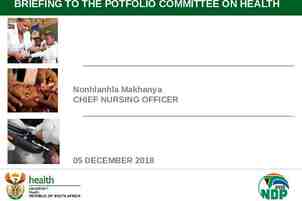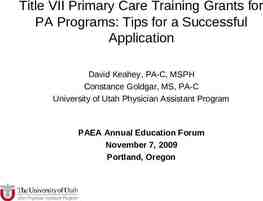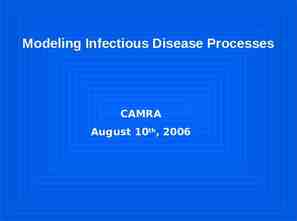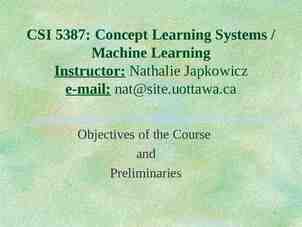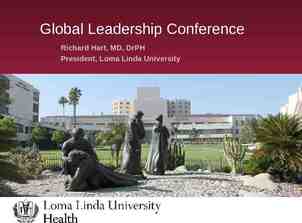Writing Measurable Student Learning Outcomes Special
27 Slides139.01 KB

Writing Measurable Student Learning Outcomes Special recognition: University of Florida

Today’s Goals Participants will be able to: Articulate specifications for learning outcomes Classify learning outcomes using Bloom’s taxonomy Write (or evaluate) student learning outcomes for your course Explain how you might assess student learning outcomes

Why is it Important? SACS-COC the Southern Association of Colleges and Schools’ Commission on Colleges State of Texas- legislative mandates Federal Student Aid Public Accountability Enhance Student Learning!

SACS Standard 3.3.1.1 3.3.1 - The institution identifies expected outcomes, assesses the extent to which it achieves these outcomes, and provides evidence of improvement based on analysis of the results in each of the following areas: (Institutional effectiveness) 3.3.1.1 educational programs, to include student learning outcomes

Definitions Student Learning Outcomes (SLOs)describe student learning – what students will know and be able to do as a result of completing a program Program Goals do not describe student learning – instead, they describe programmatic elements, such as admission criteria, acceptance and graduation rates, etc

definitions Outputs describe and count what we do and whom we reach, and represent products or services we produce. Processes deliver outputs; what is produced at the end of a process is an output. An outcome is a level of performance or achievement. It may be associated with a process or its output. Outcomes imply measurement - quantification - of performance.

Outcomes and outputs: What is the difference? This distinction is important, especially in the development and review of Student Learning Outcomes. We seek to measure outcomes as well as their associated outputs; however, SLOs focus on outcomes. For example, while we produce a number of new graduates (the output), it is critical that we have a measure of the quality of the graduates as defined by the college or discipline (the outcome). Effective Student Learning Outcomes describe, in measurable terms, these quality characteristics by defining our expectations for students at the end of the course or program.

characteristics of effective student learning outcomes Focus on what students will know and be able to do. All disciplines have a body of core knowledge that students must learn to be successful as well as a core set of applications of that knowledge in professional settings. Describe observable and measureable actions or behaviors. Effective SLOs present a core set of observable, measureable behaviors. Measurement tools vary from quizzes and tests to complex rubrics. The key to measurability: an active verb that describes a observable behavior, process, or product A framework for developing SLOs: Bloom’s Taxonomy

Verbs and phrases that complicate measurability Understand An internal process that is indicated by demonstrated behaviors –not recommended for program or course SLOs Appreciate; value Internal processes that are indicated by demonstrated behaviors closely tied to personal choice Become familiar with Focuses assessment on “becoming familiar,” not familiarity Learn about, think about Not observable; demonstrable through communication or other demonstration of learning Become aware of, gain an awareness of Focuses assessment on becoming and/or gaining – not actual awareness Demonstrate the ability to Focuses assessment on ability, not achievement or demonstration of a skill Also introduce, cover, present .

Learning Objectives? To introduce the basic principles of learning and the biological processes . Attend a live theater event and discuss its impact on them as an audience member who has a knowledge of theater history. To familiarize students with 9 to 10 literature or literature related books. Understanding of American history.

Better or worse? Why? The students will be able to understand regression models and time series models in economics. The students will be able to interpret and develop regression models and time series models in economics.

Better or worse? Why? Students will know the differences in major contemporary theories in the field of sociology Students will be able to contrast major contemporary theories in the field of sociology

Developing Measurable SLOs: A Three-level Model (carriveau, 2010)

1. 2. Prepare to engage in lifelong learning Exhibit the skills necessary to acquire, organize, reorganize, and interpret new knowledge Show proficiency in current technologies and the ability to adapt to emerging technologies Recognize and participate in activities that enhance wellness of body, mind, and spirit Formulate a plan of personal goals for continued professional growth Demonstrate intellectual curiosity 7. Demonstrate social, cultural, and global competence Live and work effectively in a diverse and global society Articulate the value of a diverse and global perspective Recognize diverse economic, political, cultural, and religious opinions and practices 6. Practice personal and social responsibility Practice ethical leadership Recognize an ethical dilemma and apply rational decision-making in order to address it Choose ethical courses of action in research and practice Acknowledge and address the consequences of one’s own actions Engage in local and global civic activities 5. Communicate effectively Demonstrate effective oral communication skills (which could include the use of languages such as American Sign language for those who do not communicate orally) Demonstrate effective writing skills Demonstrate effective nonverbal communication skills (which could include appropriate use of performance, design, or representations such as maps, tables, and graphs) Listen actively and critically Present work effectively to a range of audiences Effectively communicate original and creative ideas 4. Demonstrate critical thinking Evaluate, analyze, and integrate information from a variety of sources Use appropriate strategies and tools to represent, analyze, and integrate information Develop critical, reasoned positions 3. Master the depth of knowledge required for a degree Articulate disciplinary and interdisciplinary theories, concepts, principles, skills, and practices Synthesize knowledge across courses and other experiences Apply knowledge from core curriculum courses, discipline-based courses, and other experiences in a range of contexts to solve problems and make decisions Work collaboratively Participate effectively in teams Consider different points of view Work with others to support a shared purpose or goal

Level 1: Learning Goals based on the MSE ALC Understandwho Students materials complete the systems and their MSE role indegree will: engineering Apply knowledge of mathematics, science and engineering principles to materials science and engineering to design and conduct experiments, as well as to analyze and interpret data Desi gn a syst em, com pone nt or proc ess to meet desir ed need s withi n reali stic cons train ts such as econ omic , envir onm ental , socia l, politi cal, ethic al, healt h and safet y, man ufact urabi lity and sust aina bility

Level 2 – Program Student Learning Outcomes for MSE Content Knowledge Apply knowledge of mathematics, science and engineering principles to materials science and engineering. Design and conduct materials science and engineering experiments and analyze and interpret the data. Critical Thinking Design a materials science and engineering system, component or process to meet desired needs within realistic economic, environmental, social, political, ethical, health and safety, manufacturability and sustainability constraints. Communication Communicate technical data and design information effectively in speech and in writing to other materials engineers.

Connecting Program SLOs to Courses MSE Curriculum Map Additional Assessments SLOs Content Knowledg e EMA3050 EMA3066 EMA4714 #1 I R A #2 EMA3080C I Critical Thinking EMA3066 EMA4223 EMA4714 #3 I R A Communication EMA3080C EMA3013C EMA3513C #4 I R A EMA3513C R EMA4714 A Senior exit survey Senior exit survey Senior exit survey Senior exit survey Assessments in the boxes marked A are conducted using specific homework, exam, or assignment questions aligned with that SLO. Source: 2011-12 MSE Academic Assessment Plan

Level 3 – Course level SLOs These are determined by the faculty to teach the course However, these should directly relate to the program SLOs

Easy Syntax . Upon completion of this course, the student will be able to:

Exercise One Quick thought

Exercise Two Syllabi Review

Review Are there learning outcomes? Observable? Measurable? Direct? Constructive advice .

Exercise Three Revise Current Syllabi

Direct or Indirect assessment?

Definitions Direct assessments of student learning are those that provide for direct examination or observation of student knowledge or skills against measurable performance indicators. Indirect assessments are those that ascertain the opinion or selfreport of the extent or value of learning experiences

Homework Review your exams or assessments Better yet have one of your colleagues review your exams or assessments Are your assessments in line with your student learning outcomes (taxonomy)? Many will say yes. On review, most assessments are at fairly low taxonomic levels. Choose a cognitive level on Bloom’s taxonomy for each question that best reflects the expectations of the question see what you find .

Additional Resources Carriveau, R. (2010). Connecting the dots – Developing student learning outcomes and outcomes-based assessments. Denton, TX: Fancy Fox Publications Suskie, L. (2009). Assessing student learning: A common sense guide (2nd ed.) San Francisco, CA: Jossey-Bass. Walvoord, B. (2010). Assessment clear and simple: A practical guide for institutions, departments, and general education (2nd ed.). San Francisco, CA: Jossey-Bass.


